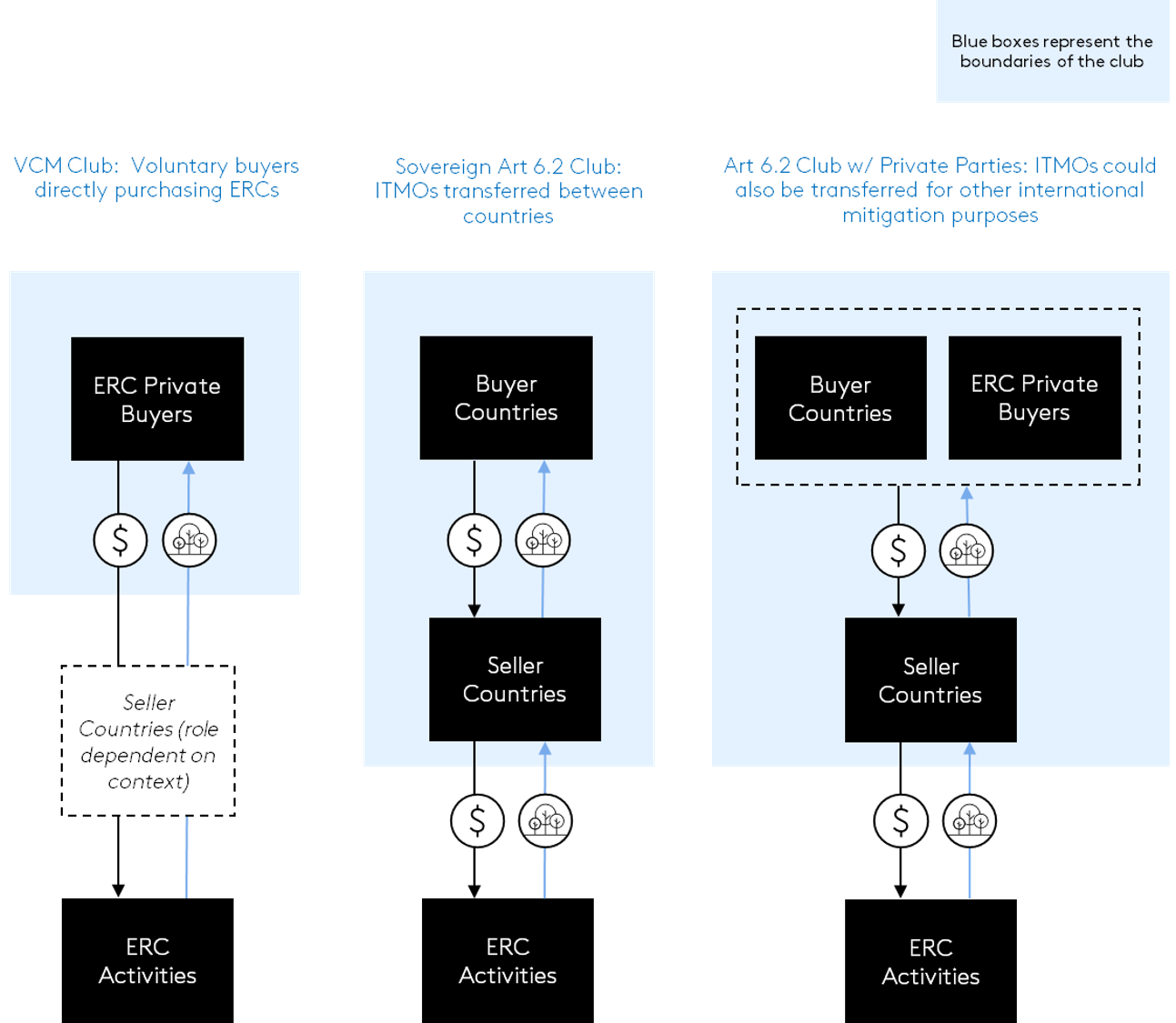Establish an ERC Club

Photo Credit: Image by Freepik
On this page: Pooling demand through an ERC buyer’s club is attractive because it helps stimulate ERC supply and allows delivery risk to be distributed across buyers. Read more below, or visit Strategic Guidance for Country System Assessments, Guidance for Countries in Assessing ERC Projects, or Mobilizing ERC Finance.
Pooling demand through an ERC buyer’s club could send a strong market signal and improve the expected cash flows of ERC activities, reducing ERC market risk and helping to unlock debt capital. Those benefits can potentially be heightened through an Article 6.2 club that provides a government-sanctioned path to market, thus also reducing political risk. Pooling demand is attractive from an ERC buyer’s perspective because it helps stimulate ERC supply and allows delivery risk to be distributed across buyers. An ERC club should serve not simply as a buyer’s club, but it can also reduce market frictions and transaction costs for ERC activities and buyers. An ERC club would act as a platform for multiple parties across the value chain of ERC financing to coalesce around specific rules and approaches that standardize all ERC transactions that occur through the club. That can create a high-integrity environment for trade while the broader market continues to mature. This could be attractive for buyers broadly to bolster the integrity of their claims of buying and using high-quality ERCs and could be particularly attractive for mid-sized buyers that might face reputational and regulatory scrutiny but find it difficult to engage in extensive due diligence of ERC purchases on its own. There are multiple potential iterations of an ERC club (Figure 15), including a: The ERC club could be designed as a standalone entity or, alternatively, could build upon or be housed in existing efforts that seek to achieve similar or complimentary goals.1 Figure 15. Illustration of potential variations of an ERC club. A DFI could help convene and organize the policies and procedures of and trade among an ERC club. For any version of an ERC club, it is critical the club has a clear and transparent governance structure that ensures consistency across the ERCs being traded and, in the case of an Article 6.2 club, minimizes the risk of double counting and leakage. This offers one potential role of DFIs, particularly multilateral institutions, which are well placed to organize and manage an ERC club thanks to their credibility and convening power. Footnote 1: See, for example, World Bank Climate Warehouse, Climate Market Club, 2023.

This section is intended to be a living document and will be reviewed at regular intervals. The Guidelines have not been prepared with any specific transaction in mind and are meant to serve only as general guidance. It is therefore critical that the Guidelines be reviewed and adapted for specific transactions. Unless expressly stated otherwise, the findings, interpretations, and conclusions expressed in the Materials in this Site are those of the various authors of the Materials and are not necessarily those of The World Bank Group, its member institutions, or their respective Boards of Executive Directors or member countries. For feedback on the content of this section of the website or suggestions for links or materials that could be included, please contact the Public-Private Partnership Resource Center at ppp@worldbank.org.
Updated:
TABLE OF CONTENTS
UNLOCKING GLOBAL EMISSION REDUCTION CREDIT
1. Introduction to Emission Reduction Credits
• The World Bank's Emission Reduction Program
• Classification of Emissions Reduction Credit
• Policy Context of Emissions Reduction Credit
• Current Landscape of ERC Financing
• Financing structures to address key risks
• Debt: Example of Emission Reduction-Linked Bond from Vietnam
• Equity: The London Stock Exchange and Foresight Sustainable Forestry
• Fund: Liveligoods Carbon Fund 3
3. Key Enablers of ERC Finance
• Credit Risk in ERC Finance Transactions
• Political Risk for ERC Activities
• Rights to ERCs and Their Benefits
• Government Engagement and Public Sector Participation
4. Scaling Finance for ERC Generation
• Key Findings to Scale Up Private Sector Capital for ERC Activities
• Expand ERC-Backed Debt Issuance
Related Content
Additional Resources
Defined Article 6 Transaction Frameworks
Type of ResourceRight Block TitleTABLE OF CONTENTSRight Block DescriptionUNLOCKING GLOBAL EMISSION REDUCTION CREDIT
Strategic Guidance for Country System Assessments
1. Introduction to Emission Reduction Credits
• The World Bank's Emission Reduction Program
• Classification of Emissions Reduction Credit
• Policy Context of Emissions Reduction Credit
2. Objective of the Strategic Guidance for Country System Assessments
• Objective of these Guidelines
• Introduction to the Country System Assessment Framework
• Process to conducting assessments
3. Framework Component Deep Dives
• I1: Appropriate Institutional Mandates
• I3: Transparency and Accountability Mechanisms in Place
• S1: Well-Defined Asset Rights
• S2: Streamlined Project Permitting
• S3: Globally Accepted Methodologies
• S4: Defined Benefit-Sharing Frameworks
• V2: Adequate VVB Capabilities
• D1: Defined Article 6 Transaction Frameworks
• D2: Develops Trading Infrastructure & Mechanisms
4. Scope for Further Refinements
• Appendix A: Approach for Cooperative Approaches
Maximizing Revenue for Funding Infrastructure
Type of ResourceRight Block TitleTABLE OF CONTENTSRight Block DescriptionI. Innovative Revenues for Infrastructure (IRI)
2. Introduction to Commercial Value Capture (CVC)
• Maximizing Revenue for Funding Infrastructure
• CVC Opportunities in Infrastructure
• Core Principles in Applying CVC in Projects
3. Applying CVC in Infrastructure Projects
Energy and Power PPPs
Type of Resource